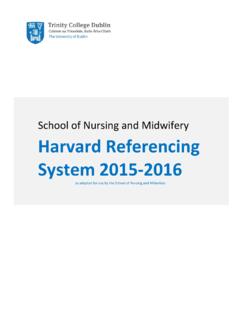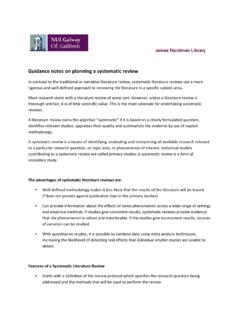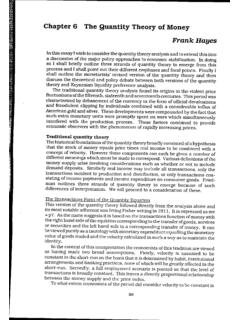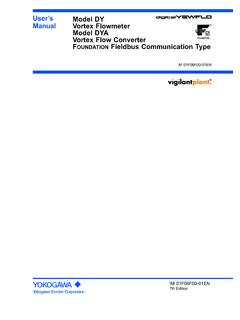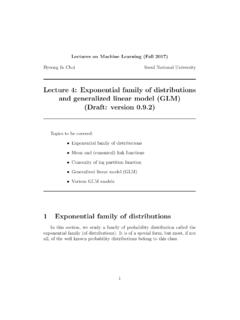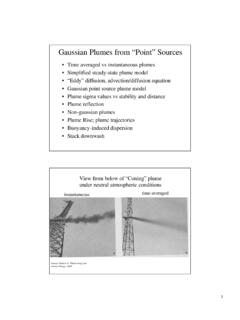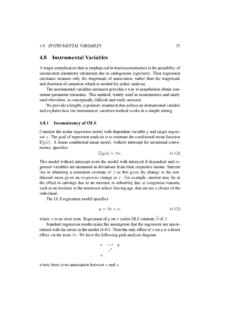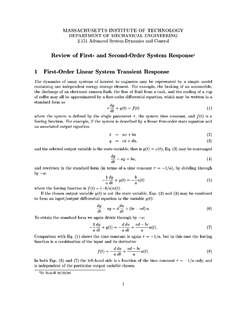Transcription of Topic 1: The Solow Model of Economic Growth
1 EC4010 Notes,2005(KarlWhelan)1 Topic1: TheSolow Model of EconomicGrowthMacroeconomicsis nota one-size- ts-alltype of wouldbe a duantingtaskto evenattemptto constructa modelthatexplainedallinterestingmacroeco nomicphenomena,andany such modelwouldundoubtedlybe complicatedandunwieldy, makingit di culttolearn(andteach).For thisreason,macroeconomiststendto adopta moreeclecticapproach,withmodelsoftenbein gdevelopedwiththeintentionof helpingto explainoneparticularaspectof rstmodelthatwe willlook at in thisclass,a modelof economicgrowthoriginallydeveloped by MIT'sRobertSolow in the1950s,is a good exampleof 'spurposein developingthemodelwas to deliberatelyignoresomeimportant aspectsof macroeconomics,such as short-run uctuationsin employment andsavingsrates,in orderto developa modelthatattemptedto describe thelong-runevolutionof theeconomy. Theresultingpaper (AContributionto theTheoryof EconomicGrowth,QJE, 1956)remainshighlyin uentialeven today and,despiteits relative simplicity, it conveysa number of veryusefulinsights aboutthedynamicsof modelis alsoworthteachingfroma methodologicalperspective becauseit providesa simpleexampleof thetype of dynamicmodelthatis commonlyusedintoday'smoreadvancedmacroec onomictheory.
2 Forthosebrave soulsamongstyouwhomay be interestedin studyingmoremacroeconomicsafterthiscours e,notethatsomeofthetricks andterminologyintroducedhere(such as theuselogsto derive growthrates,andtheconceptsof steady-stategrowthandconvergent dynamics)arewidespreadin Asideon NotationWe areinterestedin modellingchangesover timein usefulmathe-maticalshorthandthatsaves us fromhavingto writedownderivatives withrespectto timeeverywhereis to write_Yt=dYtdt(1)Whatwe arereallyinterestedin,though,isgrowthrat esof series:If I tellyouGDPwasupby 5 millioneuros,thatmay soundlike a lot,butunlesswe scaleit by theoveralllevelof GDP, it' ,whatwe areinterestedin calculatingis_YtYt, andthisis ourmathematicalexpressionforthegrowthrat eof a ,2005(KarlWhelan)2 TheSolow Model 'sIngredientsThemodelassumesthatGDP is producedaccordingto anaggregateproductionfunctiontechnology. It is worth aggingthatmostof thekeyresultsforSolow'smodelcanbeobtaine dusingany of thestandardproductionfunctionsthatyousee in microeconomicproductiontheory.
3 However,forconcreteness,I amgoingto be speci candlimitus to thecasein which theproductionfunctiontakes theCobb-Douglasform:Yt=AtK tL1 t0< <1(2)whereKtis capitalinputandLtis higheroutputwithouthavingto callincreasesinAt\technologicalprogress" andwe willlooselyreferto thisas the\technology"term,butultimatelyAtis simplya measureof productive e ciency. BecauseanincreaseinAtincreasestheproduct ivenessof theotherfactors,it is alsosometimesknownasTotalFactorProductiv ity(TFP),andthisis thetermmostcommonlyusedin empiricalpapersthatattemptto additionto theproductionfunction,themodelhasfouroth erequations. Capitalaccumulatesaccordingto_Kt=Yt Ct Kt(3)In otherwords,theadditionto thecapitalstock each period dependspositivelyonsavings(thisis a closed-economy modelso savingsequalsinvestment) andnegativelyondepreciation,which is assumedto take placeat rate . Labourinputgrowsat raten:_LtLt=n(4) Technologicalprogressgrowsat rateg:_AtAt=g A fractionsof outputis savedeach Ct=sYt(5)EC4010 Notes,2005(KarlWhelan)3We have notputtimesubscriptsontherateof populationgrowth,therateof tech-nologicalprogress,therateof depreciationof capitalor thesavingsrate,becausewe willgenerallyconsiderthesetobe constant:TheSolow modeldoes notattempttoexplain uctuationsin ,we dowishto charaterisethedynamicsof themodelwell enoughto be ableto gureoutwhathappensif ,forinstance,we willbe interestedin whathappenswhenthereis a once-o increasein Digressionon the ProductionFunctionTwo well-knownfeaturesof theCobb-Douglasproductionfunctionarewort hrecappinghere: Constant returnsto scale(a doublingof inputsleadsto a doublingof outputs).
4 At( Kt) ( Lt)1 = 1 Yt= Yt(6) Decreasingmarginalreturnsto factoraccumulation(addingextracapitalwhi lehold-inglabourinput xedyieldsever-smallerincreasesin output):@Y@K= AtK 1tL1 t(7) @2Y@K!= ( 1)AtK 2tL1 t<0(8)Thisturnsoutto be thekeyelement of it is sensible:If a rmacquiresanextraunitof capital,it the rmkeepspilingonextracapitalwithoutraisin gthenumber of workersavailableto usethiscapital,theincreasesin outputwillprobablytaper o .IntheCobb-Douglascase,theparameter dictatesthepaceof thistaperingo .ModellingDynamicsusingTricks withLogsOneof thepurposesof thisclassis to teach you sometricks 'sthe rst:Theuseof logarithimscanbe thefollowingproperty:d(logYt)dt=d(logYt) dYtdYtdt=_YtYt(9)EC4010 Notes,2005(KarlWhelan)4 Thegrowthrateof a seriesis thesameas thederivative of itslogwithrespectto time(notetheuseof chain-ruleof di erentiationin theabove equation.)Two otherusefulpropertiesof logarithmsthatwillalsohelpus characterisethedynamicsof theSolow modelarethefollowing:log(XY) =logX+ logY(10)log XY =YlogX(11)We canapplyeach of thesepropertiesto geta usefulrepresentationof thegrowthrateofoutput:log(Yt) =log(AtK tL1 t)(12)=log(At) + log(K t) + log(L1 t)(13)=log(At) + log(Kt) + (1 ) log(Lt)(14)Now takingthederivative withrespectto time,we gettherequiredformula:_YtYt=_AtAt+ _KtKt+ (1 )_LtLt(15)Thistakes us fromtheCobb-Douglasformulainvolvinglevel sto a outputper worker is simply_YtYt _LtLt=_AtAt+ _KtKt _LtLt!
5 (16)Thus,therearetwo sourcesof increasesin outputper worker: Technologicalprogress Capitaldeepening( capitalper worker)TheSolow modelprovidesa usefulframeworkforunderstandinghow technologicalprogressandcapitaldeepening interactto determinethegrowthrateof outputper rstthingwe aregoingto dowiththeSolow modelis gureoutwhatthiseconomylookslike alonga pathonwhich outputgrowthis constant. Macroeconomistsreferto suchconstant don'tnecessarilywant to studyEC4010 Notes,2005(KarlWhelan)5onlyconstant-grow thpaths,butwe willseebelow thattheSolow-modeleconomy tendstoconvergeover ,givenconstant growthratesfortechnologyandlabourinput,a llvaria-tionsin outputgrowtharedueto variationsin thegrowthrateof capitalinput:_YtYt=g+ _KtKt+ (1 )n(17)Soforoutputgrowthto be constant, we mustalsohave canalsoshow thatthesegrowthratesforcapitalandoutputm ustbe thesame,sothatthecapital-outputratiois constant alonga constant seethis,re-writethecapitalaccumulationeq uationas_Kt=sYt Kt(18)anddivideacrossbyKtonbothsides_KtK t=sYtKt (19)Thegrowthrateof thecapitalstock dependsnegativelyonthecapital-outputrati oKtYt.
6 So,forthecapitalstock to be growingat a constant rate,thenKtYtmustbe constant. ButKtYtcanonlybe constant if thegrowthrateofKtis thesameas mind,we seethatthesteady-stategrowthratemustsati sfy_YtYt=g+ _YtYt+ (1 )n(20)Subtracting _YtYtfrombothsides,we get(1 )_YtYt=g+ (1 )n(21)So,thesteady-stategrowthrateis_YtY t=g1 +n(22)Onlythegrowthrateof technology,g, andthefactorcontrollingtheextent of diminishingmarginalreturnsto capital, , cana ectthegrowthrateof outputper a key result:Alltheotherparametershaveno e ,economieswithhighersavingratesdonothave fastersteady-stateEC4010 Notes,2005(KarlWhelan) is this?Anincreasein thesavingratecanraisethegrowthrateinitia llyby :Equation(19)tellsus output,butcanotgettheeconomy to a pathinvolvinga quali cationto thedecompositionof growthintocapitaldeepeningandtechnologic alprogressgivenby equation(16).Such decompositions(knownasgrowthaccountingst udies)
7 Arequitecommonlycarriedout,withresearche rsconcludingthata certainfractionof thegrowthin outputper worker over a ,thesecalculationsarebasedonanarithmetic decompositionof thegrowthin outputper worker,andshouldnotbe confusedwithaneconomictheoryexplainingth eultimatesourcesof ,theSolow modeltellsusthatwe shouldbe carefulnottodraw fromsuch calculationsthatpoliciesbasedsolelyonenc ouragingcapitaldeepeningarecapableof boostingthegrowthratein of capitalimpliesthatsteadygrowthcannotbe , it is technologicalprogressthato setsthee ectsof diminishingmarginalreturns,andthus allowscapitaldeepeningto play a UsefulExpressionfor OutputPer WorkerOurnextgoalis to providea fullcharacterisationof thedynamicsof capitalandoutputin theSolow dothis,thereis a particularcharacterisationof outputper workerthatturnsoutto be ,letus de nethecapital-outputratioasxt=KtYt(23)So, theproductionfunctioncanbe expressedasYt=At(xtYt) L1 t(24)Here,we areusingthefactthatKt=xtYt(25)EC4010 Notes,2005(KarlWhelan)7 Dividingbothsidesof thisexpressionbyY t, we getY1 t=Atx tL1 t(26)Takingbothsidesof theequationto thepower of11 we arrive atYt=A11 tx 1 tLt(27)So,outputper worker isYtLt=A11 tx 1 t(28)Thisequationtellsus thatall uctuationsin outputper worker aredueto eitherchangesin technologicalprogressor changesin assumedtogrow at a constant rateeach period, thismeansthatallof theinterestingdynamicsforoutputper hourstemfromthebehaviourof willnow describehow the Capital-OutputRatioUsingourterminologyfo rthecapital-outputratio,we canre-writeequation(19)as_KtKt=sxt (29)Againusinglogarithmtricks,notethatlo gxt= logKtYt= logKt+ log1Yt= logKt+ logYt 1= logKt logYt(30)Takingderivatives withrespectto timewe have_xtxt=_KtKt _YtYt(31)
8 Now usingequation(17)foroutputgrowthandequat ion(29)forcapitalgrowth,we canderive a usefulequationforthedynamicsof thecapital-outputratio:_xtxt=(1 )_KtKt g (1 )n(32)=(1 )(sxt g1 n )(33)Thisdynamicequationhasa veryimportant property:Thegrowthrateofxtdependsnegativ elyonthevalueofxt. In particular,whenxtis over a certainvalue,it willtendtoEC4010 Notes,2005(KarlWhelan)8decline,andwhenit is underthatvalueit willtendto : It tendsto convergeto a speci thislong-runvalue,which we willlabelx ? It is thevalueconsistent with_xx= 0. Thisimpliesthatsx g1 n = 0(34)Thissolves to givex =sg1 +n+ (35)Given thisexpressionforthesteady-statecapital- outputratio,we canalsoderive a moreintuitive-lookingexpressionto describe theconvergencepropertiesof dothisby bothmultiplyinganddividingtheright-hand- sideof equation(33)by (g1 +n+ ):_xtxt= (1 )(g1 +n+ ) s=xt g1 n g1 +n+ !(36)Thelastterminsidethebracketscanbe simpli edto give_xtxt=(1 )(g1 +n+ ) 1xtsg1 +n+ 1!
9 (37)=(1 )(g1 +n+ ) x xt 1 (38)=(1 )(g1 +n+ ) x xtxt (39)Thisequationstatesthateach period thecapital-outputratioclosesa fractionequalto(1 )(g1 +n+ ) of thegapbetweenthecurrent valueof of OutputPer WorkerWe have derivedthedynamicbehaviourof thecapital-outputratioin theSolow turnsoutto be pretty easyto alsoderive themodel'spredictionsforthebehaviourofou tputper becauseoutputper worker is determinedbyAt, which we knowfollowsa setpath,andby thecapital-outputratio,whosedynamicswe have seethis,applythetake-logs-and-derivative s trick to equation(28)to getthegrowthrateof outputper worker in termsof technologicalprogressandchangesin thecapital-EC4010 Notes,2005(KarlWhelan)9outputratio:_YtYt _LtLt=11 _AtAt+ 1 _xtxt(40)Substitutingin thegrowthrateofxfromequation(39)to get_YtYt _LtLt=g1 + (g1 +n+ ) x xtxt (41)Outputgrowthequalsthesteady-stategro wthrateg1 plusor minus thatelement us anexpressionforthesteady-statepathforout putper worker, outputis always convergingin whichxt=x.
10 Thisis obtainedby pluggingthesteady-statecapital-outputrat iointo equation(28)to get YtLt =A11 t sg1 +n+ ! 1 (42)Thisformulaprovidesa way to calculatethelong-rune ectsonthelevel of outputperworker of changesin thesavingsrate, : ConvergenceDynamicsOften,thebestway to understanddynamicmodelsis to loadthemonto easilydoneusingspreadsheetsoftwaresuch as Excelor econometrics-orientedpackagessuch as to 3 provideexamplesof thebehaviourover timeof two economies,onethatstartswitha capital-outputratiothatis halfthesteady-statelevel,andotherthatsta rtswitha capitaloutputratiothatis 0:2; =13; g= 0:02; n= 0:01; = 0 witha steady-statecapital-outputratioof 2. To see,thisplugthesevaluesinto (35): KY =sg1 +n+ =0:21:5 0:02 + 0:01 + 0:06= 2(43)The rstchartshowshow thetwo capital-outputratiosconverge,somewhatslo wly,over timeto convergenceis dictatedby ourchoiceofparameters:Our\convergencespe ed"is: = (1 )(g1 +n+ ) =23(1:5 0:02 + 0:01 + 0:06)= 0:067(44)EC4010 Notes,2005(KarlWhelan)10So,thecapital-ou tputratioconvergesto itssteady-statelevel at a rateof about7 percentper ,so thisshouldbeunderstood to mean7 percent per outputper worker evolves over timein thesetwo ,butthecapital-pooreconomy growsfasterduringtheconvergenceperiod thanthecapital-rich economy.


